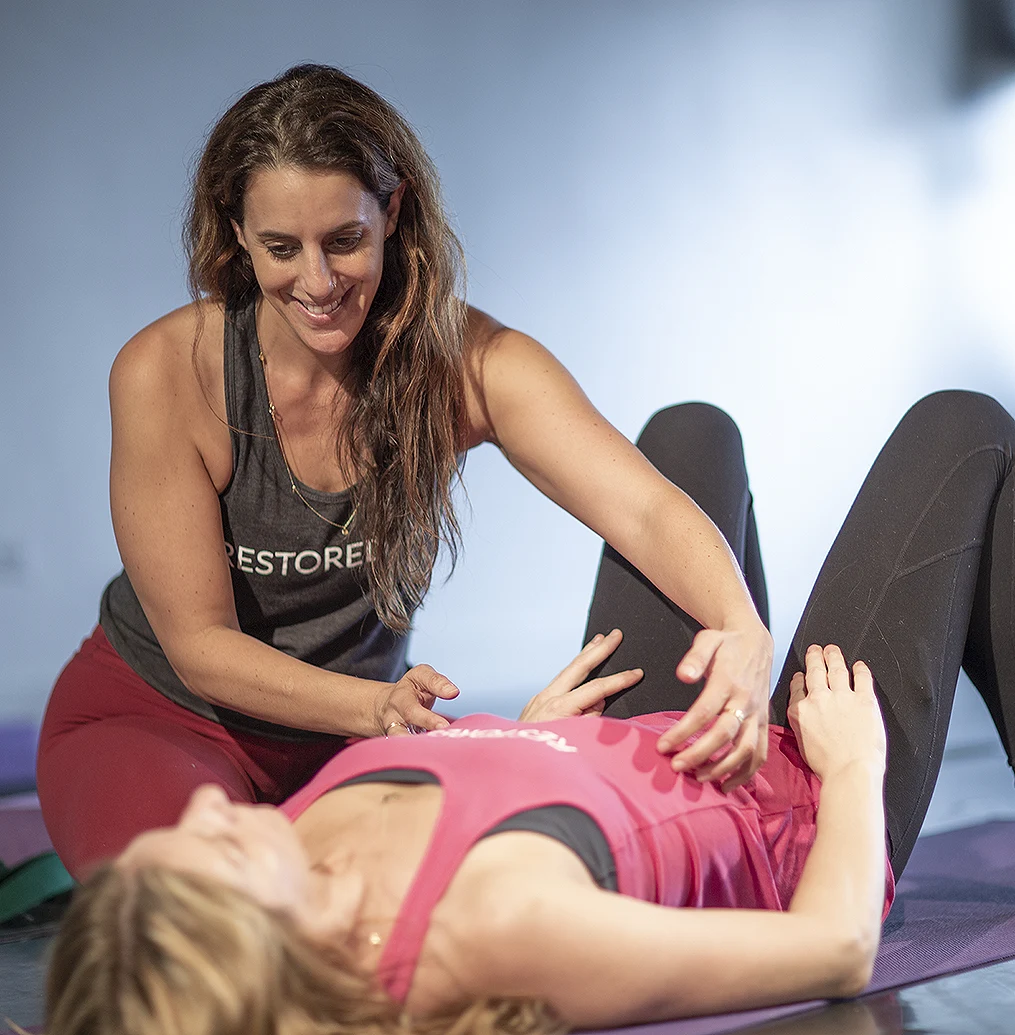You see, the “secret” to healing diastasis recti
is NOT in hundreds of crunches.

Your ability to get back to the body you remember (or want to build) is completely dependent on building a strong core that knows how to engage when it needs to.
Spot treatment or programs that promise flat bellies too soon are a fast track to re-injury and disappointment.
You don’t need endless crunches and leg raises.
True healing can happen in a diastasis recti program that understands your core is a part of your whole, functioning body – including the pelvic floor and other stabilizing muscles.
Introducing: Restore Your Core®
The online program that builds the responsive core you need to heal diastasis recti and strengthen your pelvic floor.
You’ll feel confident
and proud of your body again.
RYC® has helped thousands of women heal their diastasis recti…
We’d love to help you too.

Healing DR with RYC® looks like able to…

Healing DR with RYC® looks like able to…
- move effortlessly without worry or fear.
- lift your kids.
- have fewer aches and pains.
- workout harder with more intensity.
- move without fear.
- listen to your body and respond.
- embrace full body healing through core rehab.
You can feel strong, confident and capable again with RYC®
You’ll have a lived experience of how your whole body functions as a system, and learn strategies for continuing to build and maintain your strength in your daily life
RYC® is the proven method for regaining your strength and confidence, long term.
Begin Your Journey
Lauren Ohayon
Founder and program developer RYC
Join the thousands of women taking back their strength and confidence
with Lauren
Got Questions
Yes! There have been many women who have completed the RYC® 12 -Week program and seen their diastasis recti close considerably, if not all the way. It’s not only possible to heal diastasis recti without surgery – in many cases, you can also restore core strength and full-body function without the need for invasive procedures.
Diastasis recti is a common postpartum recovery challenge. When the muscles of her abdominal wall separate, it can be difficult for them to come back together on their own and you may need physical therapy or a structured core rehab program if they don't heal within 6 weeks to 3 months following delivery. Using the RYC® method greatly increases your likelihood of being able to heal without surgery. Surgery is usually only considered in extreme cases if the gap doesn’t close within a year of physical therapy.
A great way to prevent worsening your diastasis recti is avoiding exercises that can make it worse. Exercises such as crunches, planks, and twists can strain the connective tissue and slow core rehab progress. It's also important not to jump quickly out of bed or do anything else that causes a visible doming in the ab muscles.
Yes, medically speaking a gap of 2 fingers or more is considered diastasis recti. However, at Restore Your Core®, we begin healing from even a one-finger gap, emphasizing early core rehabilitation to prevent the issue from progressing.
Diastasis recti can lead to back pain, digestive issues, urine leaking and lots of general discomfort. It can also stop you from being able to workout efficiently and reach your goals safely. In some rare cases tissue tears can lead to hernias where organs begin to poke out of the openings in your tissues. The RYC® program targets full-body healing, not just cosmetic results, to address these long-term concerns.
Wearing a binder or splint won’t strengthen or tighten the muscles, so it won’t actually heal diastasis recti. But it may give you some relief from lower back pain.
We know you’re hoping for a definitive answer, but in our professional opinion the response is not so simple. If you’re well past the 8 week postpartum mark, adding in low intensity exercises can be a great way to begin regaining strength. But this can look different for each person depending on what you’re experiencing in your body. If you’d like to hear Lauren’s opinion, feel free to tag her in a post where you share a bit about your own body in our Facebook group.
A self-test for abdominal muscle separation can help. Belly fat feels soft and diffused, while diastasis often presents as a bulge or a gap along the midline, especially when the muscles are engaged.
We recommend scrolling up the page and following along with Lauren’s video of how to test if you have a diastasis recti. She goes through exactly how to feel whether you have a gap yourself.
Drinking water is important for your overall health, and you need to be taking care of your health as you heal your diastasis recti. Drinking water is definitely one of the good habits you should pick up as you move toward whole-body healing. It doesn’t always have to be plain water though, diluted juices or herbal teas are also great for keeping you hydrated.
A hernia is the tearing of your tissue which allows organs to poke through. Diastasis recti is the separation of the abdominal muscles that happens when your linea alba (the tissue in the center of your abs) weakens.
While they aren’t the same thing, diastasis recti can sometimes look like an inguinal or umbilical hernia when you flex your abdomen, as you can sometimes see a bulge through your skin where your belly button would be.
Incorporating safe diastasis recti exercises is an effective way to restore strength and support core stability.
Diastasis recti doesn’t only cause bulging in the middle – it can also cause a dip, depending on YOUR body. Your abdominal muscles have stretched and separated which can either show up as a bulge or a dip.
A space of more than 2.7-3cm at the level of your belly button is considered severe or pathological. BUT over 50% of women have pathological or severe diastasis recti immediately following delivery. Remember, severe doesn’t mean there isn’t a path to healing, and we’ve had many women with severe diastasis recti use the RYC® method with success.
Yes, it can. Because your abdominal muscles aren’t working in the same way, your digestive system can become more sensitive and need extra support.
For many women, food intolerances that weren’t a problem before become important to address. Common foods that cause trouble are gluten, dairy and sugar, eliminating these and trying intermittent fasting helps many women, but consulting a nutritionist or dietician is always a good idea.
Restore Your Core® (RYC®) is one of the most highly recommended programs for non-surgical diastasis recti recovery. Created by pelvic floor specialist Lauren Ohayon, RYC® combines posture education, breathing techniques, and progressive strength training to rebuild your core from the inside out. Tens of Thousands of users have reduced their gaps and improved function with this comprehensive, accessible method.









 Lifetime access
Lifetime access 




















